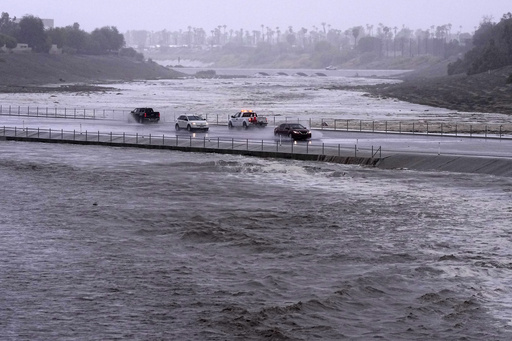
Vehicles cross over a flood control basin that has almost reached the street, Sunday, Aug. 20, 2023, in Palm Desert, Calif. AP
LOS ANGELES — Tropical Storm Hilary drenched Southern California from the coast to inland mountains and deserts Sunday evening, prompting rescues from swollen rivers and forcing some of the nation’s largest school districts to cancel Monday classes. Millions braced for more flooding and mudslides, even as the storm began to weaken.
The first tropical storm to hit Southern California in 84 years, Hilary dropped more than half an average year’s worth of rain on some mountain and desert areas, including the desert resort city of Palm Springs, which saw nearly 3 inches of rain by Sunday evening.
Forecasters warned of dangerous flash floods across Los Angeles and Ventura Counties, and fire officials rescued 13 people from knee-deep water in a homeless encampment along the rising San Diego River. Meanwhile, rain and debris washed out some roadways and people left their cars stranded in standing water. Crews pumped floodwaters out of the emergency room at Eisenhower Medical Center in Rancho Mirage.
The storm walloped California after making landfall in Mexico’s arid Baja California Peninsula on Sunday in a sparsely populated area about 150 miles (250 kilometers) south of Ensenada. It then moved through mudslide-prone Tijuana, threatening the improvised homes that cling to hillsides just south of the U.S. border.
The storm was projected to weaken as it continued moving northward over California and into Nevada, but threats remained. Richard Pasch, a hurricane specialist with the National Hurricane Center, said the storm should become a “post-tropical cyclone” sometime Monday as it loses a well-defined center, but that “very heavy” rain and strong winds are still likely.
The Los Angeles Unified School District, the nation’s second largest school system, and said all campuses would be closed on Monday, as did districts across the region. San Diego schools postponed the first day of classes from Monday to Tuesday.
“There is no way we can compromise the safety of a single child or an employee, and our inability to survey buildings, our inability to determine access to schools makes it nearly impossible for us to open schools,” Superintendent Alberto Carvalho said at a media briefing.
Southern California got another surprise in the afternoon as an earthquake with a preliminary magnitude of 5.1 hit near Ojai, about 80 miles (130 km) northwest of downtown Los Angeles, according to the U.S. Geological Survey. It was felt widely and was followed by smaller aftershocks. There were no immediate reports of major damage or injury, according to a dispatcher with the Ventura County Sheriff’s Office.
Hilary is just the latest major climate disaster to wreak havoc across the U.S., Canada and Mexico. Hawaii’s island of Maui is still reeling from a blaze that killed over 100 people and ravaged the historic town of Lahaina, making it the deadliest U.S. wildfire in more than a century. Firefighters in Canada are battling that nation’s worst fire season on record.
As Hilary bore down on Mexico, one person drowned Saturday in the Mexican township of Mugele, on the eastern side of the Baja Peninsula, when a vehicle was swept away by an overflowing stream. Rescue workers saved four other people, said Edith Aguilar Villavicencio, the mayor of Mulege.
Mexican army troops fanned out across the area, where some of the worst damage occurred Saturday. Soldiers used bulldozers and dump trucks to help clear tons of boulders and earth clogging streets and roads that were turned into raging torrents a day earlier.
Power lines were toppled in many places, and emergency personnel were working to restore power and reach those cut off by the storm.
The Palm Springs Police Department said in a statement Sunday that 911 lines were down and that in the event of an emergency to text 911 or respond to the nearest police or fire station.
On Sunday morning in California, the warnings from officials didn’t keep everyone indoors. In coastal Carlsbad, just north of San Diego, 19-year-old Jack Johnson and his friends kept an eye on the huge waves, determined to surf them at some point Sunday.
“It’s really choppy out there, not really surfable yet, but I think we can find a good break somewhere later,” Johnson said. “I can’t remember a storm like this.”
Also Sunday, one of several budding storm systems in the Atlantic Ocean became Tropical Storm Emily, according to the National Hurricane Center. It was far from land, moving west in the open ocean. Meanwhile, Tropical Storm Franklin formed in the eastern Caribbean. Tropical storm watches were issued for the southern coasts of Haiti and the Dominican Republic.
In Sept. 1939, a tropical storm that roared into California ripped apart train tracks, tore houses from their foundations and capsized many boats, killing nearly 100 people on land and at sea.